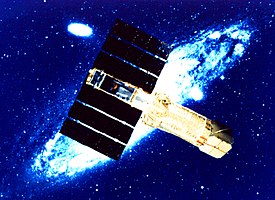 | |||||||||
| Names | ASTRO-D, Asuka | ||||||||
|---|---|---|---|---|---|---|---|---|---|
| Mission type | X-ray observatory | ||||||||
| Operator | ISAS / NASA | ||||||||
| COSPAR ID | 1993-011A | ||||||||
| SATCAT no. | 22521 | ||||||||
| Website | http://heasarc.gsfc.nasa.gov/docs/asca/ | ||||||||
| Mission duration | Final: 8 years, 10 days | ||||||||
| Spacecraft properties | |||||||||
| Manufacturer | NEC | ||||||||
| Launch mass | 420 kg (930 lb) | ||||||||
| Dimensions | 4.7 m (15 ft) long | ||||||||
| Start of mission | |||||||||
| Launch date | 20 February 1993, 02:20 UTC | ||||||||
| Rocket | Mu-3SII, mission M-3SII-7 | ||||||||
| Launch site | Kagoshima Space Center, Japan | ||||||||
| Contractor | ISAS | ||||||||
| End of mission | |||||||||
| Disposal | deorbited | ||||||||
| Decay date | 2 March 2001, 14:20 UTC | ||||||||
| Orbital parameters | |||||||||
| Reference system | Geocentric | ||||||||
| Regime | Low Earth | ||||||||
| Eccentricity | 0.01 | ||||||||
| Perigee altitude | 523.6 km (325.3 mi) | ||||||||
| Apogee altitude | 615.3 km (382.3 mi) | ||||||||
| Inclination | 31.1° | ||||||||
| Period | 96.09 minutes | ||||||||
| Epoch | 20 February 1993 | ||||||||
| Main telescope | |||||||||
| Type | Wolter | ||||||||
| Diameter | 1.2 m (3.9 ft) | ||||||||
| Focal length | 3.5 m (11 ft) | ||||||||
| Collecting area | 1,300 cm2 (200 sq in) @ 1 kev 600 cm2 (93 sq in) @ 7 keV | ||||||||
| Wavelengths | X-ray, SIS: 3–0.12 nm (0.4–10 keV)[1] GIS: 1.8–0.12 nm (0.7–10 keV)[2] | ||||||||
| |||||||||
The Advanced Satellite for Cosmology and Astrophysics (ASCA, formerly named ASTRO-D) was the fourth cosmic X-ray astronomy mission by JAXA, and the second for which the United States provided part of the scientific payload. The satellite was successfully launched on 20 February 1993. The first eight months of the ASCA mission were devoted to performance verification. Having established the quality of performance of all ASCA's instruments, the spacecraft provided science observations for the remainder of the mission. In this phase the observing program was open to astronomers based at Japanese and U.S. institutions, as well as those located in member states of the European Space Agency.[3][4]
- ^ "Solid-state Imaging Spectrometers". 25 June 2001. Retrieved 26 November 2016.
Energy Range: 0.4 keV to 10 keV keV
- ^ "Gas Imaging Spectrometers". 1 April 2005. Retrieved 26 November 2016.
Energy Range : 0.7 keV to 10 keV
- ^ Cite error: The named reference
nasascimiswas invoked but never defined (see the help page). - ^ Tanaka, Yasuo; Inoue, Hajime; Holt, Stephen S. (June 1994). "The X-ray astronomy satellite ASCA". Publications of the Astronomical Society of Japan. 46 (3): L37–L41. Bibcode:1994PASJ...46L..37T.